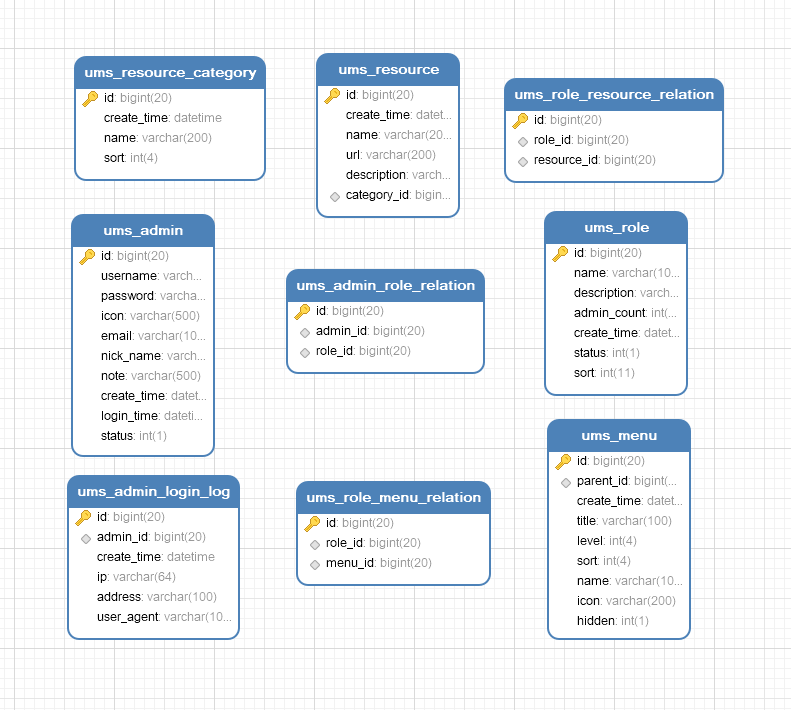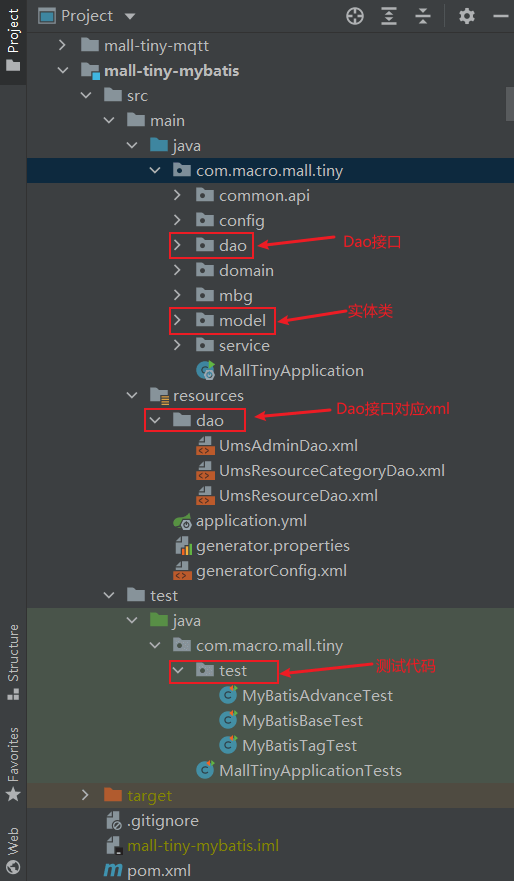学习不走弯路,通过《mall视频教程(最新版)》,使用更系统、高效的方式来学习mall电商实战项目吧!
MyBatis这样用,同事直呼哇塞,堪称最佳实践!
MyBatis这样用,同事直呼哇塞,堪称最佳实践!
MyBatis是一款非常流行的ORM框架,相信很多小伙伴都在使用。我们经常会把它和MyBatis-Plus或者MBG一起使用,用多了之后对于其一些常规操作就不太熟悉了。最近总结了下MyBatis的实用用法和技巧,希望对大家有所帮助!
MyBatis简介
MyBatis是一款优秀的开源持久层框架,支持自定义SQL查询、存储过程和高级映射,目前在Github上已有17k+Star。在MyBatis中,我们可以在XML中编写SQL语句,然后绑定到Java方法中,通过参数和结果集的自动映射来实现复杂的查询逻辑。MyBatis消除了几乎所有JDBC操作和手动绑定参数操作,使用起来非常方便!
在SpringBoot中集成
下面我们来聊聊MyBatis在SpringBoot中的使用,首先我们需要集成它。
- 在
pom.xml中添加MyBatis提供的Spring Boot Starter;
<dependency>
<groupId>org.mybatis.spring.boot</groupId>
<artifactId>mybatis-spring-boot-starter</artifactId>
<version>2.2.2</version>
</dependency>- 然后在
application.yml中配置好编写SQL实现的xml文件路径,这里我们存放在resources/dao目录下;
mybatis:
mapper-locations:
- classpath:dao/*.xml- 然后添加Java配置,通过
@MapperScan配置好Dao接口路径,这样就可以开始使用了。
/**
* MyBatis配置类
* Created by macro on 2019/4/8.
*/
@Configuration
@MapperScan("com.macro.mall.tiny.dao")
public class MyBatisConfig {
}基本使用
下面我们来聊聊MyBatis的基本使用方法,涵盖了基本的增删改查操作。
表结构说明
这里将以mall项目中权限管理模块相关表为例进行介绍,具体表结构如下。

项目结构说明
本文示例使用了mall-learning项目中的mall-tiny-mybatis模块代码,具体项目结构如下。

select
- 首先是查询操作,这里我们以后台用户表
ums_admin为例,编写一个根据ID查询用户的方法,先创建实体类UmsAdmin;
public class UmsAdmin implements Serializable {
private Long id;
private String username;
private String password;
@ApiModelProperty(value = "头像")
private String icon;
@ApiModelProperty(value = "邮箱")
private String email;
@ApiModelProperty(value = "昵称")
private String nickName;
@ApiModelProperty(value = "备注信息")
private String note;
@ApiModelProperty(value = "创建时间")
private Date createTime;
@ApiModelProperty(value = "最后登录时间")
private Date loginTime;
@ApiModelProperty(value = "帐号启用状态:0->禁用;1->启用")
private Integer status;
}- 然后创建数据操作的接口
UmsAdminDao,再添加对应的方法;
/**
* 自定义UmsAdmin表查询
* Created by macro on 2022/10/20.
*/
@Repository
public interface UmsAdminDao {
/**
* 根据ID查询用户
*/
UmsAdmin selectByIdSimple(Long id);
}- 再创建
xml文件UmsAdminDao.xml,添加查询方法的SQL实现;
<select id="selectByIdSimple" resultType="com.macro.mall.tiny.model.UmsAdmin">
select * from ums_admin where id = #{id}
</select>- 然后编写测试类,注入Dao,调用Dao方法来进行测试;
/**
* MyBatis基本操作测试
* Created by macro on 2022/10/20.
*/
@SpringBootTest
public class MyBatisBaseTest {
private static final Logger LOGGER = LoggerFactory.getLogger(MyBatisBaseTest.class);
@Autowired
private UmsAdminDao umsAdminDao;
@Test
void testSelectByIdSimple(){
UmsAdmin umsAdmin = umsAdminDao.selectByIdSimple(1L);
LOGGER.info("testSelectByIdSimple result={}",umsAdmin);
}
}- 此时你会发现,对于一些数据库表中以
下划线分割的返回字段无法自动映射,可以通过对字段取别名的方式来进行映射;
<select id="selectById" resultType="com.macro.mall.tiny.model.UmsAdmin">
select username,
password,
icon,
email,
nick_name as nickName,
note,
create_time as createTime,
login_time as loginTime,
status
from ums_admin
where id = #{id}
</select>- 如果你觉得这种方式比较麻烦,也可以通过在
application.yml中开启全局下划线自动转驼峰功能来解决,个人习惯使用第一种。
mybatis:
configuration:
# 下划线自动转驼峰
map-underscore-to-camel-case: trueinsert
- 接下来我们来编写一个
插入单个用户的方法;
/**
* 自定义UmsAdmin表查询
* Created by macro on 2022/10/20.
*/
@Repository
public interface UmsAdminDao {
/**
* 插入用户
*/
int insert(UmsAdmin entity);
}- 然后在xml中编写对应的SQL实现,这里需要注意的是如果想返回插入后的自增ID的话,需要使用
selectKey标签进行配置。
<insert id="insert">
insert into ums_admin(username, password, icon, email, nick_name, note, create_time, login_time)
values (#{username}, #{password}, #{icon}, #{email}, #{nickName}, #{note}, #{createTime}, #{loginTime})
<selectKey keyColumn="id" resultType="long" keyProperty="id" order="AFTER">
SELECT LAST_INSERT_ID()
</selectKey>
</insert>update
- 接下来我们来编写一个
根据ID修改用户信息的方法;
/**
* 自定义UmsAdmin表查询
* Created by macro on 2022/10/20.
*/
@Repository
public interface UmsAdminDao {
/**
* 根据ID修改用户信息
*/
int updateById(UmsAdmin entity);
}- 然后在xml中编写对应的SQL实现。
<update id="updateById">
update ums_admin
set username = #{username},
password = #{password},
icon = #{icon},
email = #{email},
nick_name = #{nickName},
note = #{note},
create_time = #{createTime},
login_time = #{loginTime}
where id = #{id}
</update>delete
- 接下来我们来编写一个
根据ID删除用户的方法;
/**
* 自定义UmsAdmin表查询
* Created by macro on 2022/10/20.
*/
@Repository
public interface UmsAdminDao {
/**
* 根据ID删除用户
*/
int deleteById(Long id);
}- 然后在xml中编写对应的SQL实现。
<delete id="deleteById">
delete from ums_admin where id = #{id}
</delete>动态SQL
通过MyBatis的动态SQL功能,我们可以灵活地在xml中实现各种复杂的操作,动态SQL功能需要依赖MyBatis的各种标签,下面我们就来学习下。
if
if标签可以实现判断逻辑,这里我们以根据用户名和Email模糊查询用户为例,来聊聊它的使用;
/**
* 自定义UmsAdmin表查询
* Created by macro on 2022/10/20.
*/
@Repository
public interface UmsAdminDao {
/**
* 根据用户名和Email模糊查询用户
* 不输入查询所有
*/
List<UmsAdmin> selectByUsernameAndEmailLike(@Param("username") String username, @Param("email") String email);
}- xml中添加对应的SQL实现如下。
<select id="selectByUsernameAndEmailLike" resultType="com.macro.mall.tiny.model.UmsAdmin">
select username,
password,
icon,
email,
nick_name as nickName,
note,
create_time as createTime,
login_time as loginTime,
status
from ums_admin
where 1=1
<if test="username!=null and username!=''">
and username like concat('%',#{username},'%')
</if>
<if test="email!=null and email!=''">
and email like concat('%',#{email},'%')
</if>
</select>choose
choose标签也可以实现判断逻辑,上面的例子中当我们不输入用户名和Email时,会查询出全部用户,我们如果想不查询出用户,可以使用它;
<select id="selectByUsernameAndEmailLike2" resultType="com.macro.mall.tiny.model.UmsAdmin">
select username,
password,
icon,
email,
nick_name as nickName,
note,
create_time as createTime,
login_time as loginTime,
status
from ums_admin
where 1=1
<choose>
<when test="username!=null and username!=''">
and username like concat('%',#{username},'%')
</when>
<when test="email!=null and email!=''">
and email like concat('%',#{email},'%')
</when>
<otherwise>
and 1=2
</otherwise>
</choose>
</select>where
- 上面的例子中我们为了SQL拼接不出错,添加了
where 1=1这样的语句,其实可以使用where标签来实现查询条件,当标签内没有内容时会自动去除where关键字,同时还会去除开头多余的and关键字。
<select id="selectByUsernameAndEmailLike3" resultType="com.macro.mall.tiny.model.UmsAdmin">
select username,
password,
icon,
email,
nick_name as nickName,
note,
create_time as createTime,
login_time as loginTime,
status
from ums_admin
<where>
<if test="username!=null and username!=''">
and username like concat('%',#{username},'%')
</if>
<if test="email!=null and email!=''">
and email like concat('%',#{email},'%')
</if>
</where>
</select>set
- 当我们拼接更新字段的语句时,也会面临同样的问题,此时可以使用
set标签来解决,比如我们现在想写一个根据ID选择性修改用户信息的方法;
/**
* 自定义UmsAdmin表查询
* Created by macro on 2022/10/20.
*/
@Repository
public interface UmsAdminDao {
/**
* 根据ID选择性修改用户信息
*/
int updateByIdSelective(UmsAdmin entity);
}- 方法对应的SQL实现如下,这里既避免了使用
set关键字,也会将多余的逗号去除。
<update id="updateByIdSelective">
update ums_admin
<set>
<if test="username!=null and username!=''">
username = #{username},
</if>
<if test="password!=null and password!=''">
password = #{password},
</if>
<if test="icon!=null and icon!=''">
icon = #{icon},
</if>
<if test="email!=null and email!=''">
email = #{email},
</if>
<if test="nickName!=null and nickName!=''">
nick_name = #{nickName},
</if>
<if test="note!=null and note!=''">
note = #{note},
</if>
<if test="createTime!=null">
create_time = #{createTime},
</if>
<if test="loginTime!=null">
login_time = #{loginTime},
</if>
</set>
where id = #{id}
</update>foreach
- 通过
foreach我们可以实现一些循环拼接SQL的逻辑,例如我们现在需要编写一个批量插入用户的方法;
/**
* 自定义UmsAdmin表查询
* Created by macro on 2022/10/20.
*/
@Repository
public interface UmsAdminDao {
/**
* 批量插入用户
*/
int insertBatch(@Param("entityList") List<UmsAdmin> adminList);
}- 在xml中的对应SQL实现如下,在
foreach标签中的内容会根据传入的集合参数进行循环拼接;
<insert id="insertBatch">
insert into ums_admin(username, password, icon, email, nick_name, note, create_time, login_time) values
<foreach collection="entityList" separator="," item="item">
(#{item.username}, #{item.password}, #{item.icon}, #{item.email}, #{item.nickName}, #{item.note}, #{item.createTime}, #{item.loginTime})
</foreach>
</insert>- 再例如我们现在需要编写一个
根据用户ID批量查询的方法;
/**
* 自定义UmsAdmin表查询
* Created by macro on 2022/10/20.
*/
@Repository
public interface UmsAdminDao {
/**
* 根据用户ID批量查询
*/
List<UmsAdmin> selectByIds(@Param("ids") List<Long> ids);
}- 在xml中的对应SQL实现如下,我们可以使用
open、close属性指定拼接语句的前后缀。
<select id="selectByIds" resultType="com.macro.mall.tiny.model.UmsAdmin">
select username,
password,
icon,
email,
nick_name as nickName,
note,
create_time as createTime,
login_time as loginTime,
status
from ums_admin
where id in
<foreach collection="ids" item="item" open="(" close=")" separator=",">
#{item}
</foreach>
</select>高级查询
介绍完MyBatis的基本操作后,我们再来介绍下MyBatis的高级查询功能。
一对一映射
- 在我们平时进行SQL查询时,往往会有
一对一的情况,比如说我们这里有资源分类ums_resource_category和资源ums_resource两张表,资源和分类就是一对一的关系,如果你不想改动原实体类的话,可以编写一个扩展类继承UmsResource,并包含UmsResourceCategory属性;
/**
* UmsResource扩展类
* Created by macro on 2022/10/20.
*/
@Data
public class UmsResourceExt extends UmsResource {
private UmsResourceCategory category;
}- 例如我们需要编写一个
根据资源ID获取资源及分类信息的方法;
/**
* 自定义UmsResource表查询
* Created by macro on 2022/10/20.
*/
@Repository
public interface UmsResourceDao {
/**
* 根据资源ID获取资源及分类信息
*/
UmsResourceExt selectResourceWithCategory(Long id);
}- 在xml中的具体SQL实现如下,我们可以通过给
ums_resource_category表中字段取以category.xxx的别名来自动进行自动映射;
<select id="selectResourceWithCategory" resultType="com.macro.mall.tiny.domain.UmsResourceExt">
select ur.id,
ur.create_time as createTime,
ur.name,
ur.url,
ur.description,
ur.category_id as categoryId,
urc.id as "category.id",
urc.name as "category.name",
urc.sort as "category.sort",
urc.create_time as "category.createTime"
from ums_resource ur
left join ums_resource_category urc on ur.category_id = urc.id
where ur.id = #{id}
</select>- 当然除了这种方式以外,我们还可以通过
ResultMap+association标签来实现,不过在此之前我们在编写xml文件的时候,一般习惯于先给当前文件写一个BaseResultMap,用于对当前表的字段和对象属性进行直接映射,例如在UmsResourceCategoryDao.xml中这样实现;
<?xml version="1.0" encoding="UTF-8"?>
<!DOCTYPE mapper PUBLIC "-//mybatis.org//DTD Mapper 3.0//EN" "http://mybatis.org/dtd/mybatis-3-mapper.dtd">
<mapper namespace="com.macro.mall.tiny.dao.UmsResourceCategoryDao">
<resultMap id="BaseResultMap" type="com.macro.mall.tiny.model.UmsResourceCategory">
<id property="id" column="id"/>
<result property="createTime" column="create_time"/>
<result property="name" column="name"/>
<result property="sort" column="sort"/>
</resultMap>
</mapper>- 在
UmsResourceDao.xml中我们可以这样实现;
<?xml version="1.0" encoding="UTF-8"?>
<!DOCTYPE mapper PUBLIC "-//mybatis.org//DTD Mapper 3.0//EN" "http://mybatis.org/dtd/mybatis-3-mapper.dtd">
<mapper namespace="com.macro.mall.tiny.dao.UmsResourceDao">
<resultMap id="BaseResultMap" type="com.macro.mall.tiny.model.UmsResource">
<id property="id" column="id"/>
<result property="createTime" column="create_time"/>
<result property="name" column="name"/>
<result property="url" column="url"/>
<result property="description" column="description"/>
<result property="categoryId" column="category_id"/>
</resultMap>
</mapper>- 编写完成后,我们的一对一
ResultMap实现就很简单了,我们可以使用association标签进行一对一管理,配置columnPrefix属性将匹配到的字段直接映射到关联对象中去;
<resultMap id="ResourceWithCategoryMap" type="com.macro.mall.tiny.domain.UmsResourceExt" extends="BaseResultMap">
<association property="category" resultMap="com.macro.mall.tiny.dao.UmsResourceCategoryDao.BaseResultMap" columnPrefix="category_"/>
</resultMap>- 然后再编写下Dao中方法对应SQL实现即可,这里直接使用上面的ResultMap,同时给
ums_resource_category表中的字段指定了category_前缀以便于映射。
<select id="selectResourceWithCategory2" resultMap="ResourceWithCategoryMap">
select ur.id,
ur.create_time,
ur.name,
ur.url,
ur.description,
ur.category_id,
urc.id as category_id,
urc.name as category_name,
urc.sort as category_sort,
urc.create_time as category_create_time
from ums_resource ur
left join ums_resource_category urc on ur.category_id = urc.id
where ur.id = #{id}
</select>一对多映射
- 在编写SQL查询时,一对多的情况也比较常见,例如这里的分类和资源就是一对多的情况;
/**
* UmsResourceCategory扩展类
* Created by macro on 2022/10/20.
*/
@Data
public class UmsResourceCategoryExt extends UmsResourceCategory {
private List<UmsResource> resourceList;
}- 例如我们现在需要编写一个
根据分类ID获取分类及对应资源的方法;
/**
* 自定义UmsResourceCategory表查询
* Created by macro on 2022/10/20.
*/
@Repository
public interface UmsResourceCategoryDao {
/**
* 根据分类ID获取分类及对应资源
*/
UmsResourceCategoryExt selectCategoryWithResource(Long id);
}- 在实现具体SQL前,我们需要先在xml中配置一个ResultMap,通过
collection标签建立一对多关系;
<resultMap id="selectCategoryWithResourceMap" type="com.macro.mall.tiny.domain.UmsResourceCategoryExt" extends="BaseResultMap">
<collection property="resourceList" columnPrefix="resource_" resultMap="com.macro.mall.tiny.dao.UmsResourceDao.BaseResultMap"/>
</resultMap>- 然后在xml中编写具体的SQL实现,使用该ResultMap。
<select id="selectCategoryWithResource" resultMap="selectCategoryWithResourceMap">
select urc.id,
urc.create_time,
urc.name,
urc.sort,
ur.id resource_id,
ur.create_time resource_create_time,
ur.name resource_name,
ur.url resource_url,
ur.description resource_description,
ur.category_id resource_category_id
from ums_resource_category urc
left join ums_resource ur on urc.id = ur.category_id
where urc.id = #{id}
</select>分页插件
- 我们平时实现查询逻辑时,往往还会遇到分页查询的需求,直接使用开源的
PageHelper插件即可,首先在pom.xml中添加它的Starter;
<!--MyBatis分页插件-->
<dependency>
<groupId>com.github.pagehelper</groupId>
<artifactId>pagehelper-spring-boot-starter</artifactId>
<version>1.4.2</version>
</dependency>- 然后在查询方法之前使用它的
startPage方法传入分页参数即可,分页后的得到的数据可以在PageInfo中获取到。
/**
* UmsResource的Service接口实现类
* Created by macro on 2022/10/20.
*/
@Service
public class UmsResourceServiceImpl implements UmsResourceService {
@Autowired
private UmsResourceDao umsResourceDao;
@Override
public PageInfo<UmsResource> page(Integer pageNum, Integer pageSize,Long categoryId) {
PageHelper.startPage(pageNum,pageSize);
List<UmsResource> resourceList = umsResourceDao.selectListByCategoryId(categoryId);
PageInfo<UmsResource> pageInfo = new PageInfo<>(resourceList);
return pageInfo;
}
}总结
本文主要介绍了MyBatis中一些比较常规的用法,涵盖了SpringBoot集成、基本查询、动态SQL和高级查询,建议大家收藏起来,在对MyBatis的用法有所遗忘的时候拿出来看看。
项目源码地址
https://github.com/macrozheng/mall-learning/tree/master/mall-tiny-mybatis
公众号
